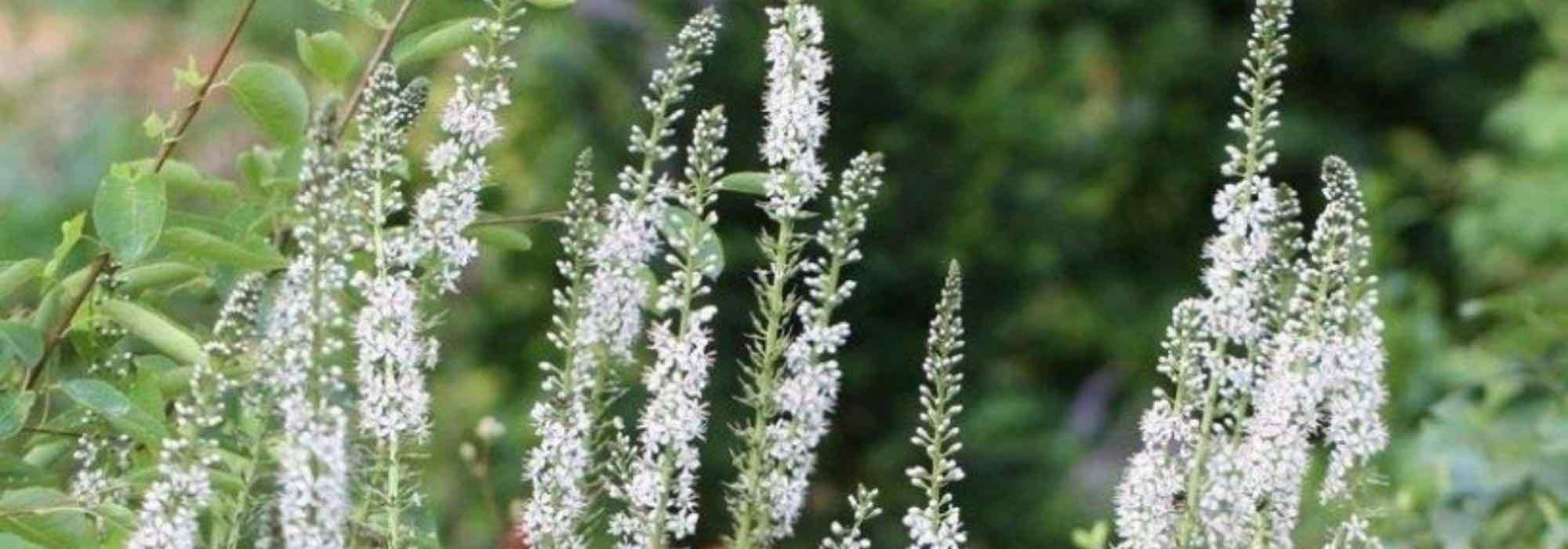
Associate the Lysimachia
with beautiful perennials for cool, moist soil
Contents
Are you despairing at the thought of not being able to plant anything in your damp, heavy soil? Consider the beautiful Lysimachias or Lysimachia, varied in style and colour, groundcover as well as tall, elegant, and original perennials, with foliage that can be vibrantly coloured. However, if you don’t live in clay, rest assured, you can still enjoy them as long as you have cool soil all year round, in full sun or partial shade. Vigorous, they quickly fill the space and brighten it with their bright yellow, white, or purple flowering. Explore the diversity of these characterful perennials that find their place in many situations and settings.
On banks or at the edge of a pond
Lysimachia thrive in the humid environments of riverbanks, so they will appreciate being placed by a water feature. In partial shade or full sun, in cool or moist, heavy soil, they flourish, for some species very quickly, so be assured of this when planting. Let’s consider a combination with Lysimachia ephemerum, which is more restrained in its growth, tall but of narrow spread, that you can pair with medium-vigour perennials without fear of it taking over.
It is accompanied by an Astilbe arendsii ‘Bumalda’ whose plump, rose-tinted plumes echo the subtle mauve hue of Lysimachia ephemerum. An Astrantia major ‘Rosea’ joins this echo, while a Carex muskingumensis offers its bright, graphic foliage. A Sanguisorba officinalis ‘Arnhem’ adds a more pronounced touch.
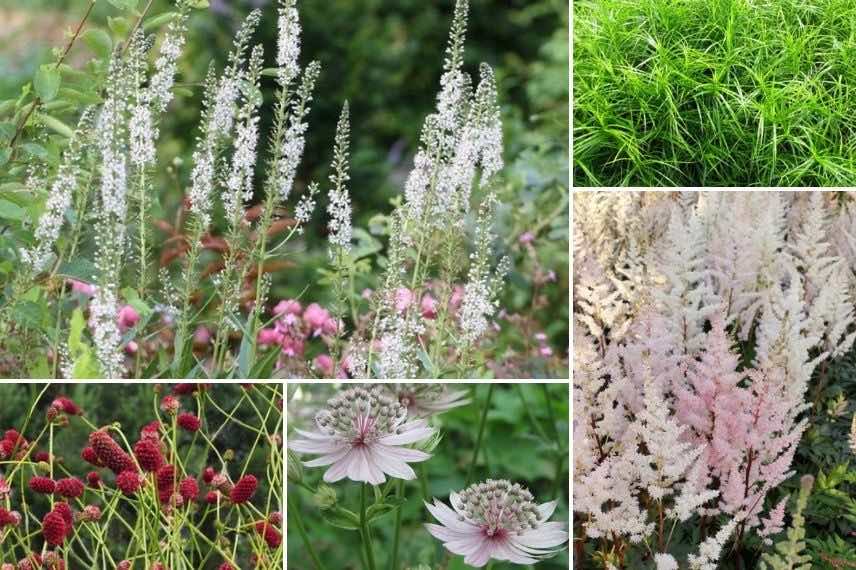
Lysimachia ephemerum, Carex muskingumensis, Astilbe arendsii ‘Bumalda’, Astrantia major ‘Rosea’, Sanguisorba officinalis ‘Arnhem’
In a bed of fresh soil
Lysimachus prefer a cool soil, provided it remains so in summer. This tempers their vigour compared to their growth in moist soil. In partial shade, they can tolerate a slight lack of water in the soil. In full sun, ensure the soil remains moist, or you may see them wilt under the sun’s onslaught. It doesn’t matter if the soil is heavy.
Lysimachus can easily fit into a classic English-style border for maximum flowers. Here, we use Lysimachia punctata in combination with an old Rose ‘Ballerina’, a Nepeta ‘Six Hill Giants’, a Foxglove ‘Suttons Apricot’, and a small Austrian Veronica ‘Royal Blue’. Here, the chosen plants prefer fairly well-drained soil, but still moist.
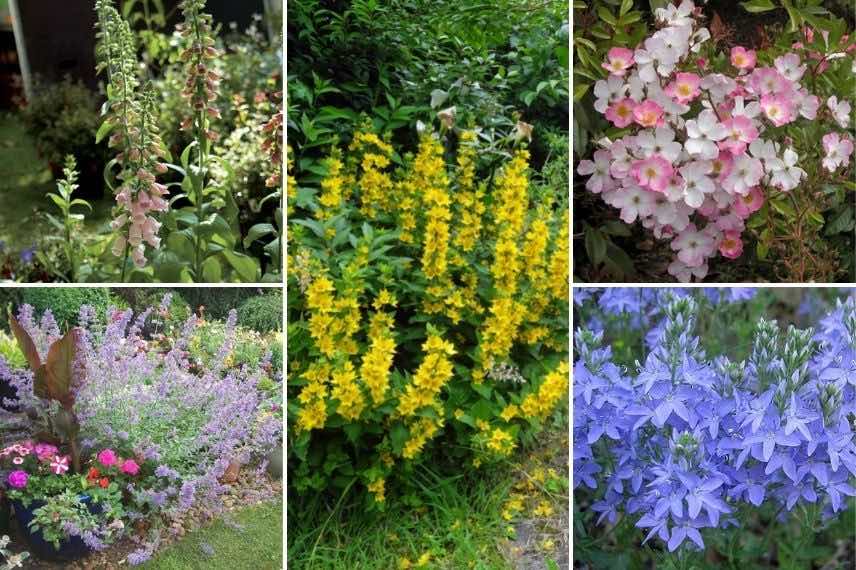
Foxglove ‘Suttons Apricot’, Lysimachia punctata, Rose ‘Ballerina’, Austrian Veronica ‘Royal Blue’, Nepeta ‘Six Hill Giants’
Discover other Lysimachia
View all →Available in 1 sizes
Available in 2 sizes
Available in 2 sizes
Available in 1 sizes
Available in 1 sizes
Available in 1 sizes
Available in 1 sizes
Available in 1 sizes
Available in 3 sizes
Available in 1 sizes
In drained soil
A variety of Lysimachia requires well-drained soil and tolerates occasionally dry soil in partial shade: Lysimachia atropurpurea ‘Beaujolais’. Very pretty and original, it has a short lifespan but can self-seed when grown under optimal conditions. With green-grey foliage turning purple and wine-red spikes, don’t hesitate to try it; lovely combinations can be made with this ephemeral floriferous plant.
Let’s take inspiration from the Chelsea Flower Show, which showcased it in a purple scene in 2014. Here it is with a Cirsium rivulare ‘Atropurpureum’, an Astrantia major ‘Shaggy’, a Rodgersia pinnata ‘Bronze Peacock’, and a Iris sibirica ‘Blue Moon’.
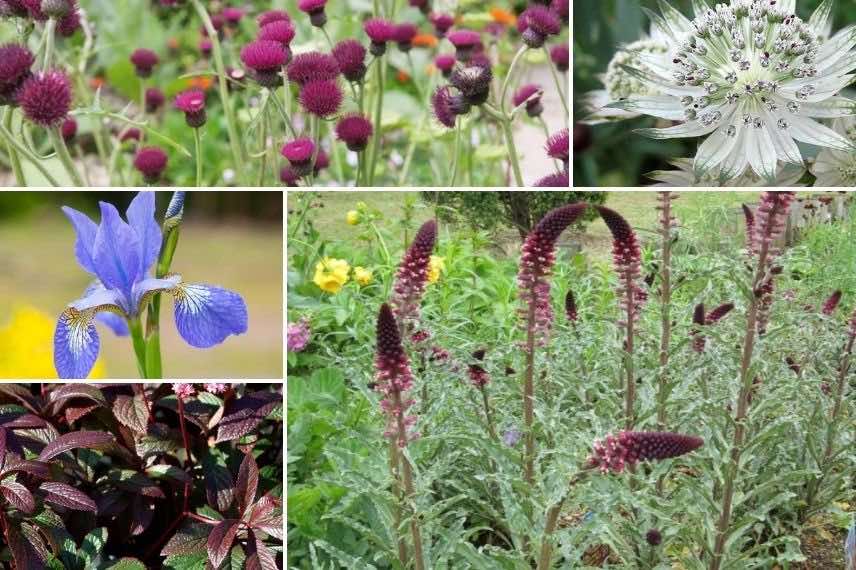
Cirsium rivulare ‘Atropurpureum’, Astrantia major ‘Shaggy’, Lysimachia atropurpurea ‘Beaujolais’, Rodgersia pinnata ‘Bronze Peacock’, Iris sibirica ‘Blue Moon’
Read also
12 perennials for heavy, wet soilAt ground level
The generous Lysimachia nummularia ‘Goldilocks’ happily occupies large areas of soil if the soil is sufficiently cool. A cheerful groundcover with small, round, pendulous leaves, it spreads quickly among your perennials in sun or partial shade. The only creeping Lysimachia, Lysimachia nummularia comes in green-leaved or golden-leaved varieties. ‘Goldilocks’ is a vigorous golden Lysimachia.
Here, like a colour gradient in partial shade, simply highlighted with blue-mauve, it is accompanied by a Heuchera ‘Southern Comfort’, a Dryopteris erythrosora, and a Phlox divaricata ‘Chattahoochee’.
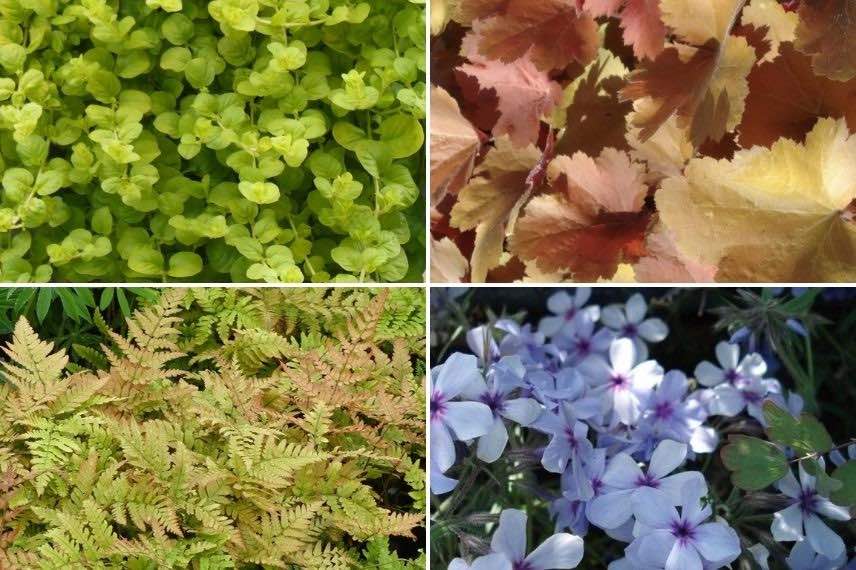
Lysimachia nummularia ‘Goldilocks’, Heuchera ‘Southern Comfort’, Phlox divaricata ‘Chattahoochee’, Dryopteris erythrosora
All in variegated style!
If you love variegated foliage, make way for the Lysimachia punctata ‘Alexander’, a beautiful variety with many advantages. Just look: its foliage, richly variegated with white, gives it a very refined silvery hue. Some leaves are also edged with pink, adding to its elegance. Its bright yellow flowering, less contrasting against its foliage than in varieties with green leaves, lends it a softness and originality. It easily pairs with a variety of plants, including those with white flowers, silvery-grey foliage, or green foliage.
Here, let’s celebrate the lovely evening-flowering perennial known as the Evening Primrose, pink with the Oenothera ‘Twilight’ resonating with the subtle pink variegation of the Lysimachia, and yellow with the Oenothera fruticosa ‘Hohes Licht’. A pennisetum orientale ‘Fairy Tails’ with fine silvery spikes and a Verbena bonariensis complete the scene.
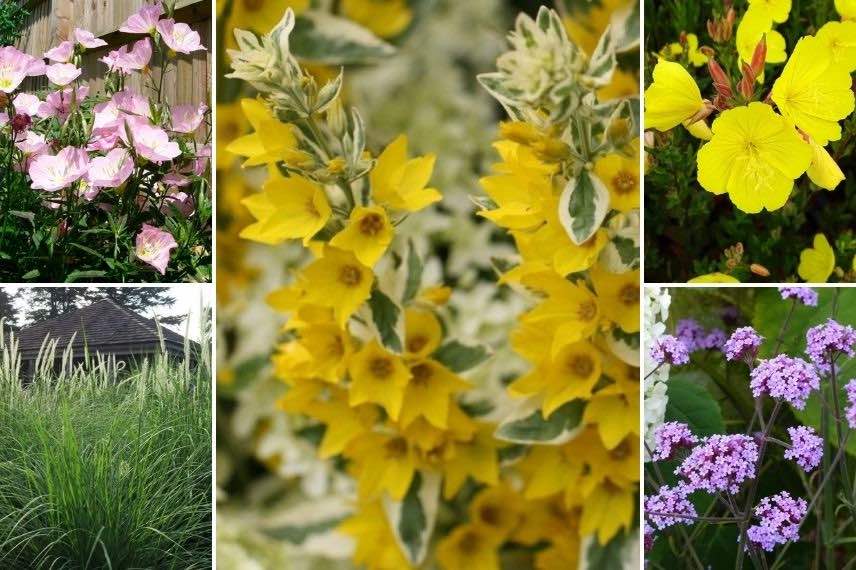
Oenothera ‘Twilight’, Lysimachia punctata ‘Alexander’, Oenothera fruticosa ‘Hohes Licht’, Verbena bonariensis, pennisetum orientale ‘Fairy Tails’
In harmony with dark foliage
What a range of shades in the foliage of Lysimachia ciliata ‘Firecracker’! Feel free to plant this original cultivar and admire the variety of reflections on its long leaves: an overall chocolate-purple impression. In sunlight, from spring to summer, coppery, bronze-green, and metallic blue reflections emerge. Autumn concludes this display with coppery russet and orange. Position its beautiful dark foliage in your garden to renew possible combinations and add depth to your scene.
Here, a harmony of dark foliage with Physocarpus opulifolius ‘Diabolo’. The Diamond Grass, Calamagrostis brachytricha, softens these two temperaments with a gentle Geranium: Geranium pratense ‘Mrs Kendall Clark’.
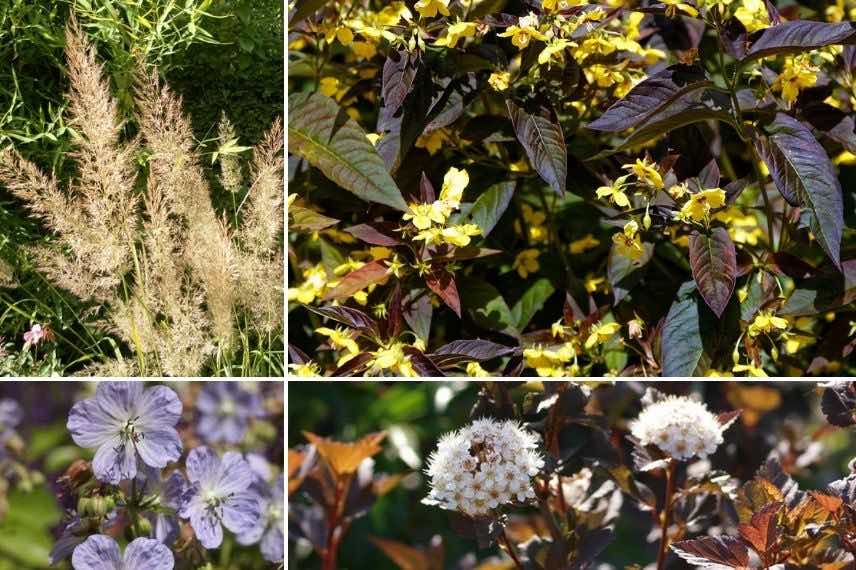
Calamagrostis brachytricha, Physocarpus opulifolius ‘Diabolo’, Lysimachia ciliata ‘Firecracker’, Geranium pratense ‘Mrs Kendall Clark’
In contrast to foliage
In contrast, let’s highlight the foliage of Lysimachia ciliata ‘Firecracker’ by creating a contrast with other ornamental foliage. Remember that the flowering period of perennials generally represents only a small moment of the year. Even though Lysimachia ciliata ‘Firecracker’ is deciduous, its foliage emerges early in spring and lasts until winter. Focus on the foliage, and you will enjoy your garden all year round!
For example, let’s try pairing it with the beautiful silver foliage of a Brunnera. In spring, its blue forget-me-not flowers also complement the foliage of the Lysimachia, which has not yet unfurled its own. The bark of a tree, such as that of white birches, adds strong appeal to this setting.
Here, the Heuchera ‘Lime Rickey’, with its bright green and frilly salad-like foliage, also piques curiosity. The Brunnera macrophylla ‘Alexander’s Great’, the Himalayan white birch, Betula utilis jacquemontii ‘Doorenbos’, and the Lysimachia get along wonderfully.

Heuchera ‘Lime Rickey’, Lysimachia ciliata ‘Firecracker’, Brunnera macrophylla ‘Alexander’s Great’, Betula utilis jacquemontii ‘Doorenbos’
In white for a bright garden
Several Lysimachias have white flowers, perfect for brightening a semi-shaded spot. With different flower shapes for a varied visual impression, you can appreciate the lightness of the Lysimachia ephemerum, the elegance of the candles of Lysimachia fortunei, or the unique presence of the swan necks of Lysimachia clethroïdes.
Let’s choose this one to plant in masses to highlight its graphic flowering alongside robust young plants that thrive in fresh soil, undeterred by competition, in partial shade or full shade: an Astilbe thunbergii ‘Prof. van der Wielen’, a fern Matteuccia pensylvanica, the very lovely Lamiastrum galeobdolon ‘Hermann’s Pride’ with its silver foliage, and the elegant Hosta fortunei ‘Patriot’.

Lysimachia clethroïdes, Lamiastrum galeobdolon ‘Hermann’s Pride’, Astilbe thunbergii ‘Prof. van der Wielen’, Matteuccia pensylvanica, Hosta fortunei ‘Patriot’
Mix the Lysimachia together.
Vigorous, the Lysimachias associated with each other create beautiful large-scale displays. They do not mind being together and enjoy the same conditions.
Once again, we find the Lysimachia ciliata ‘Firecracker’. You can appreciate its versatility; it will easily fit into many different settings and styles. It is accompanied by the Lysimachia punctata. Don’t hesitate to also use the Lysimachia vulgaris, which is slightly shorter. As a groundcover, the Lysimachia nummularia weaves between its taller siblings. Add a lovely Euphorbia, the Euphorbia griffithii ‘Fireglow’, attractive in many ways with its olive foliage, red stems, and unique orange-red flowering.
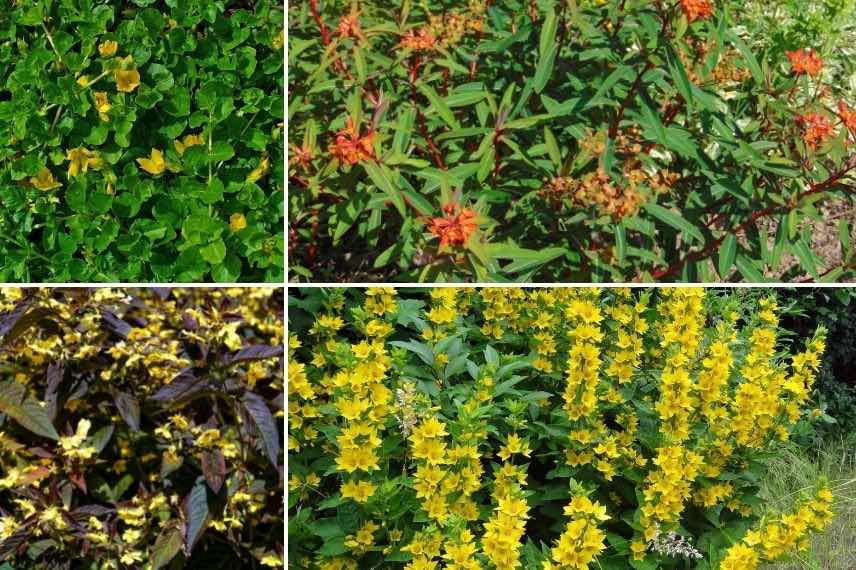
Lysimachia nummularia, Euphorbia griffithii ‘Fireglow’, Lysimachia punctata, Lysimachia ciliata ‘Firecracker’
In pot
The creeping Lysimachia, Lysimachia nummularia, can be grown in pots where it cascades beautifully and adds its light to many displays, especially the golden Lysimachia. However, it is essential to ensure consistent watering to keep the substrate constantly moist. In this case, it is probably more sensible to grow it in partial shade to maintain more freshness in the substrate, lest it dry out quickly and the plant become leggy before your eyes!
Another Lysimachia that will suit this use or as a groundcover is the Lysimachia congestiflora ‘Persian Chocolate’. Be aware that this one is not very hardy; it can withstand brief frosts down to -7 °C. However, it thrives in shade, even if it is less floriferous, making it an asset in pot culture for the reasons mentioned in the previous paragraph. Its long flowering contrasts beautifully with its foliage, making it a plant of definite interest. Paired with an Alstroemeria ‘Duchesses Alienor’, which is slightly more hardy, you achieve a lovely mix.

The Lysimachia congestiflora ‘Persian Chocolate’ on the left and below, at different times of the season, and the Alstroemeria ‘Duchesse Alienor’
- Subscribe!
- Contents
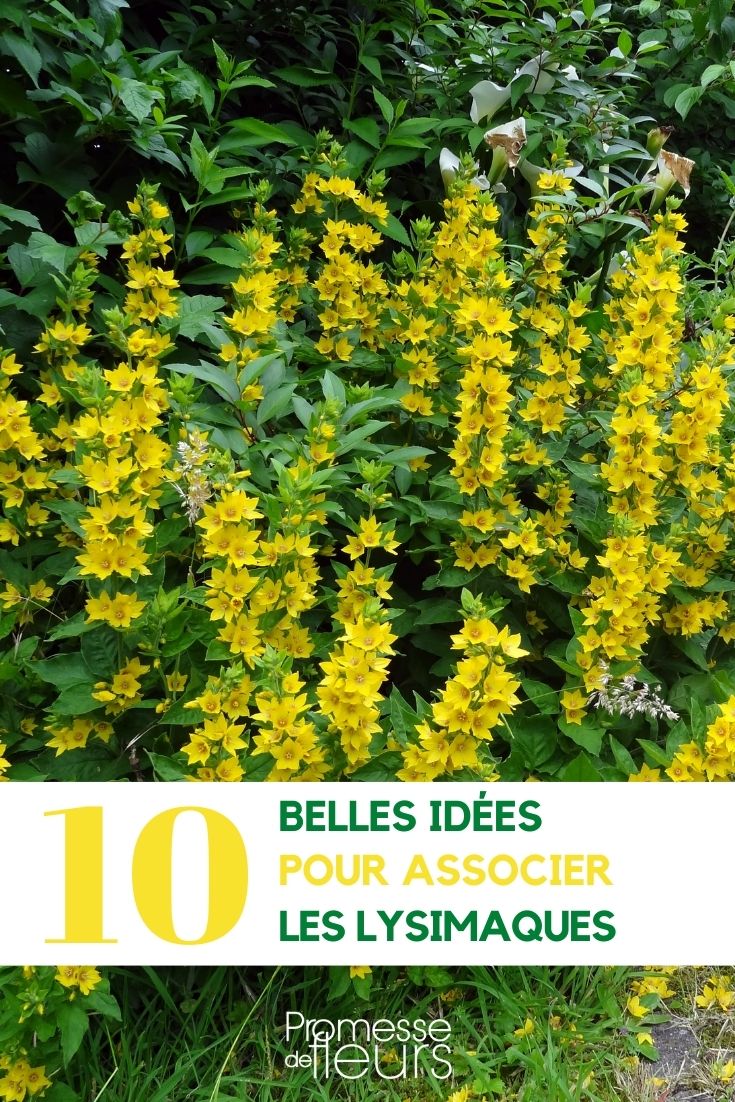
































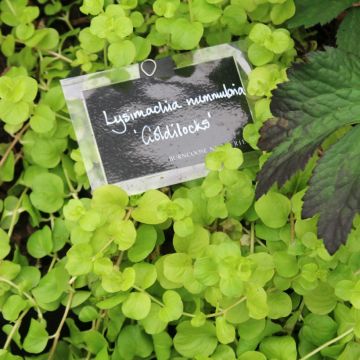

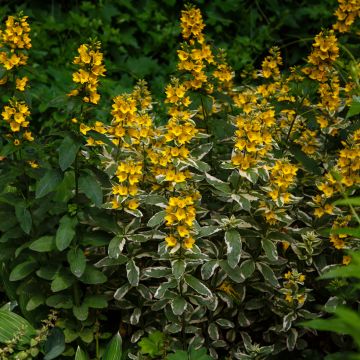
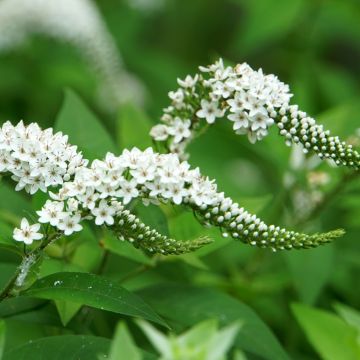
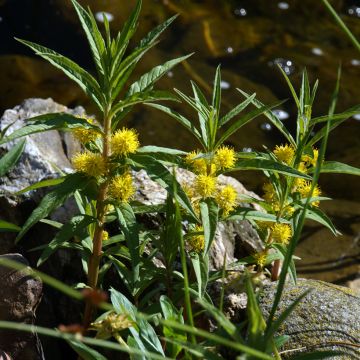
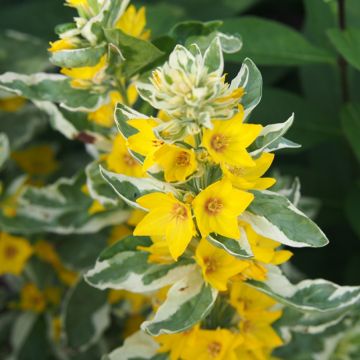
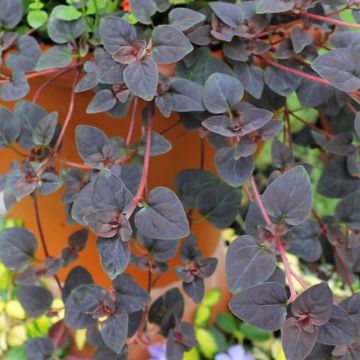
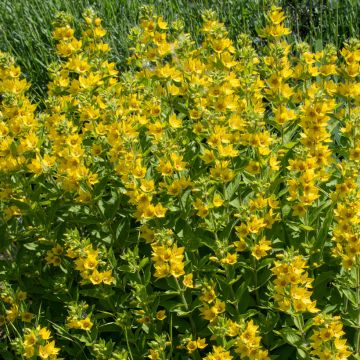

Comments